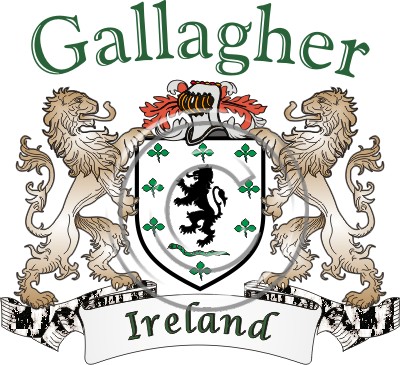There are no products listed under this category.

Gallagher is the anglicisation of the Irish surname Ó Gallchobhair (or a newer spelling form: Ó Gallchóir), these being masculine forms; the corresponding feminine forms are Ní Ghallchobhair (newer form Ní Ghallchóir). Apart from the aforementioned spelling there are at least 30 recorded variants including Gallacher, Gallager, Gallaher, Galliher, Gallaugher, Galagher, Galegher, and Goligher.
It is the most common surname in County Donegal and the fourteenth most common by birth records in Ireland. In the United States, it was ranked by the 2000 U.S. Census as the 574th most common name out of over 80,000 surnames found. According to Professor Edward MacLysaght, in the mid 20th century Gallagher was one of the most common Irish surnames, most of the recorded births being located in the north-west provinces of Ulster and Connacht, with the majority being recorded in the homeland of the sept - Co Donegal.
The Ó Gallchobhair sept claims to be the most senior family of the Cenél Conaill. The sept's territory was spread across the areas within the modern baronies of Raphoe and Tirhugh in Co Donegal. From the 14th century until the 16th century, the sept's chiefs were marshals in the O'Donnells' military forces. The principal branch of the family was centred at Ballybeit and Ballynaglack.
Redmond O'Gallagher was appointed Bishop of Killala by Pope Paul III in 1545 and presumably was recognized by the Crown in the reign of Queen Mary I, but there is no record of his recognition by Queen Elizabeth I. In 1569, Redmond O'Gallagher was appointed Bishop of Derry. He died in office on the 15 March 1601.
Donat O'Gallagher, O.F.M. succeeded Redmond as Bishop of Killala in 1570. In 1580, Donat was appointed Bishop of Down and Connor and died in office in 1581.
In the Annals of the Four Masters, on 14 September 1607, mention by Tadhg Ó Cianáin is made of five Gallaghers named Cathaoir (mac Toimlin), Cathaoir (mac Airt), Toirleach Corrach, Tuathal and Aodh Og who fled Ireland with the O'Donnells. They stayed in Belgium and joined the O'Neill regiment in the Spanish Army of Flanders. The regiment fought against the Dutch during the Eighty Years' War. Aodh Ó Gallchobhair and his wife (mentor and nursemaid of O'Donnell sons) chose to travel with the O'Donnells to Rome.
The Gallagher coat of arms displays a black lion rampant on a silver shield, (white) treading on a green snake surrounded by eight green trefoils. The correct heraldic description is, "Field argent a lion rampant sable treading on a serpent in fess proper between eight trefoils vert." The crest which surmounts the helmet over the shield depicts a red crescent surrounding a green snake or, to give its heraldic definition, "A crescent gules out of the horns a serpent erect proper." The motto of the clan is in Latin Mea Gloria Fides ("The Faith is My Glory").
The clan hails from the barony of Tirhugh ("land of Hugh") near Ballyshannon, County Donegal, Ireland.
The derivation of the surname Gallagher is "foreign help" or "foreign helper" from the Irish gall meaning "stranger" and cobhair meaning "help". It is a matter of conjecture whether this appellation denoted merely an ally of strangers from other parts or, as has been suggested, more particularly a collaborator with the Norsemen, who were in those days raiding the coast of north west Ireland. The family's origins are with the chieftain Aodh, a name corresponding to the English Hugh (whence Tirhugh), a lineal descendant of Conall Gulban son of 5th century High King and warlord Niall Noígíallach, known in English as Niall of the Nine Hostages, who is reputed to have brought St Patrick to Ireland as a slave. Aodh established his dunarus or residence at a place corresponding to the present day townland of Glassbolie in Tirhugh. The chieftains of his line ruled in relative peace for several generations until the arrival of the Vikings in Donegal Bay in the 9th century. The ruling chieftain of the time, whose real name is not recorded, was almost certainly obliged to come to some accommodation with the foreign invader resulting in the nickname "Gallcóbhair" which has been applied to his descendants thereafter.
Variant spellings of the Irish surname Gallgher are Gallacher, Gallager, Gallaher, Galliher, Gallaugher, Galagher, Galegher, Goligher, and others.
We can offer more information about the Gallagher family name and crest with two heirloom-quality gifts. Click on the links to see and shop for framed Farrell name histories and coat of arms.
We carry many other products, including clothing, glassware, flags and more, all of which can be personalized with the Gallagher coat of arms and name. Our Irish Coat of Arms page has gift ideas for Gallaghers and other Irish families.
The Gallagher family has at least one namesake establishment in Ireland, Gallaghers & J.P. Clarke's in Bunratty, County Clare. If you can't visit in person, our personalized Gallagher pub gifts are the next best thing!
G
There are no products listed under this category.